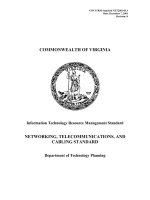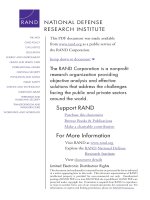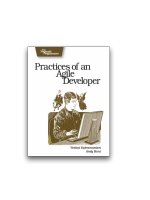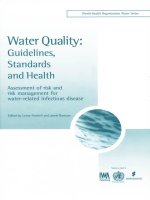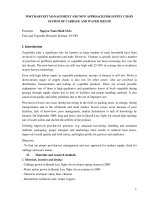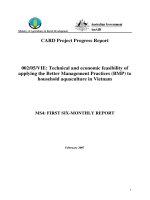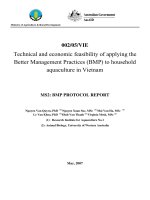Practices of Irrigation & On-farm Water Management Volume 2
Bạn đang xem bản rút gọn của tài liệu. Xem và tải ngay bản đầy đủ của tài liệu tại đây (6.1 MB, 571 trang )
Practices of Irrigation & On-farm Water
Management: Volume 2
M.H. Ali
Practices of Irrigation
& On-farm Water
Management: Volume 2
Foreword by M.A. Salam
123
Dr. M.H. Ali
Agricultural Engineering Division
Bangladesh Institute of Nuclear
Agriculture (BINA)
Mymensingh 2202, BAU Campus
Bangladesh
(URL: www.mhali.com)
ISBN 978-1-4419-7636-9
DOI 10.1007/978-1-4419-7637-6
Springer New York Dordrecht Heidelberg London
© Springer Science+Business Media, LLC 2011
All rights reserved. This work may not be translated or copied in whole or in part without the written
permission of the publisher (Springer Science+Business Media, LLC, 233 Spring Street, New York,
NY 10013, USA), except for brief excerpts in connection with reviews or scholarly analysis. Use
in connection with any form of information storage and retrieval, electronic adaptation, computer
soft-ware, or by similar or dissimilar methodology now known or hereafter developed is forbidden.
The use in this publication of trade names, trademarks, service marks, and similar terms, even if they are
not identified as such, is not to be taken as an expression of opinion as to whether or not they are subject
to proprietary rights.
Printed on acid-free paper
Springer is part of Springer Science+Business Media (www.springer.com)
Foreword
Agricultural technologies are very important to feed the growing world population.
Scientific principles of agricultural engineering have been applied for the optimal
use of natural resources in agricultural production for the benefit of humankind. The
role of agricultural engineering is increasing in the coming days at the forthcoming
challenges of producing more food with less water, coupled with pollution hazard
in the environment and climate uncertainty.
Irrigation is continually straining our limited natural resources. Whether it is
through salinity, waterlogging, sedimentation, nutrient transport, or excessive water
consumption, irrigation has an impact on our natural ecosystems. It is therefore
important that the irrigation system is properly designed, monitored, and executed
not only for the benefit of the irrigator but also for the wider community.
I am happy to know that a book (2nd volume in series) entitled “Practices of
Irrigation and On-farm Water Management,” written by Engr. Dr. M. H. Ali, is
going to be published by Springer. This book is designed to cover the major fields
of applied agricultural engineering such as designing water conveyance systems,
selecting and designing irrigation systems, land and watershed management, per-
formance evaluation of irrigation systems, drainage system, water resources man-
agement, management of salt-affected soils, pumps, renewable energy for irrigation,
models and crop production functions in irrigation management, and GIS in
irrigation management.
This book will be quite useful for the students of agricultural engineering.
Students of other related branches of engineering sciences, and engineers work-
ing in the field and at research institutes, will also be benefited. The book may serve
as a textbook for the students and as a practical handbook for the practitioners and
researchers in the field of irrigation and on-farm water management. Utilization of
the recent literature in the area and citation of relevant journals/reports have added
a special value to this book.
v
vi Foreword
I hope this textbook will be used worldwide to promote agricultural production
and conservation of the most important natural resource, water.
(Dr. M.A. Salam)
Mymensingh, Bangladesh Director (Research)
May, 2010 Bangladesh Institute of Nuclear Agriculture
Preface
Crop production depends on the successful implementation of the agricultural and
water management technologies. This is vital to feed the growing world population.
The implementation of technologies is also important to minimize environmental
degradation resulting from agricultural activities. Agricultural and natural resources
engineers are applying scientific principles for the optimal use of natural resources
in agricultural production.
Water is the scarcest resource. The importance of the judicious use of water in
agricultural sector for sustaining agricultural growth and the retardation of environ-
mental degradation needs no elaboration. Judicious use of water for crop production
requires knowledge of water conveyance and application methods, their design-
ing, strategic management of water resources, land and watershed management, etc.
Increasing efficiency in conveyance and pumping systems are also of great concern.
Irrigation management strategy practiced in normal soils may not be appropriate in
problematic soils such as saline soils. This book covers all of the above aspects.
In addition, the book covers some recent dimensions such as pollution from agri-
cultural fields, modeling in irrigation and water management, application of the
geographical information system (GIS) in irrigation and water management, and
renewable energy resources for irrigation. Sample workout problems are provided
to explain the design and application methodologies in practice.
The comprehensive and compact presentation of this book will serve as a text-
book for undergraduate students in Agricultural Engineering, Biological Systems
Engineering, Bio-Science Engineering, Water Resource Engineering, and, Civil and
Environmental Engineering. It will also be helpful for the students of relevant fields
such as Agronomy, Biological Sciences, and Hydrology. Although the target audi-
ence of this book is undergraduate students, postgraduate students will also be
benefited from the book. It will also serve as a reference manual for field engineers,
researchers, and extension workers in several fields such as agricultural engi-
neering, agronomy, ecology, hydrology, civil, water resource, and environmental
engineering.
Effort was made to keep the language as simple as possible, keeping in mind the
readers of different language origins. Throughout the book, the emphasis has been
on general descriptions and principles of each topic, technical details, and modeling
vii
viii Preface
aspects. However, the comprehensive journal references in each area should enable
the reader to pursue further studies of special interest. In fact, the book covers broad
interdisciplinary subjects.
Dr. M.H. AliMymensingh, Bangladesh
Acknowledgment
I acknowledge the cooperation, suggestions, and encouragement of the faculty
members of the Department of Irrigation and Water Management, Bangladesh
Agricultural University. I would like to thank Engr. Dr. M. A. Ghani, former Director
General of Bangladesh Agricultural Research Institute, and World Bank Country
Representative, Bangladesh, who critically reviewed the content and structure of
several chapters of the Book. I would also like to thank the scientists and staffs of
Agricultural Engineering Division, Bangladesh Institute of Nuclear Agriculture, for
their cooperation in various ways.
Thanks are due to Dr. M. A. Salam, Director (Research), Bangladesh Institute of
Nuclear Agriculture, for going through the book and writing few words about the
same in the form of a “Foreword.”
I am grateful to the authority of Soil Moisture Co. for supplying the pictures of
their products and giving me permission to use the same in the book.
My sincere thanks are also due to my affectionate wife Anjumanara Begham,
daughter, Sanjida Afiate, and son, Irfan Sajid, for their support, understanding, and
patience during the preparation of the manuscript.
Dr. M.H. AliMymensingh, Bangladesh
May, 2010
ix
Contents
1 Water Conveyance Loss and Designing Conveyance System 1
1.1 Water Conveyance Loss . . . 2
1.1.1 Definition of Seepage 2
1.1.2 Factors Affecting Seepage . 2
1.1.3 Expression of Seepage . . . 3
1.1.4 Measurement of Seepage . . 4
1.1.5 Estimation of Average Conveyance Loss
inaCommandArea 7
1.1.6 Reduction of Seepage . . . 8
1.1.7 Lining for Reducing Seepage Loss . . 8
1.2 Designing Open Irrigation Channel . . 10
1.2.1 Irrigation Channel and Open Channel Flow . 10
1.2.2 Definition Sketch of an Open Channel Section . . . 10
1.2.3 Considerations in Channel Design . . 11
1.2.4 Calculation of Velocity of Flow in Open Channel . . 12
1.2.5 Hydraulic Design of Open Irrigation Channel 14
1.2.6 Sample Examples on Irrigation Channel Design . . . 18
1.3 DesigningPipeforIrrigationWaterFlow 21
1.3.1 Fundamental Theories of Water Flow
Through Pipe . . . 21
1.3.2 Water Pressure – Static and Dynamic Head . 23
1.3.3 Hydraulic and Energy Grade Line for Pipe Flow . . 25
1.3.4 Types of Flow in Pipe – Reynolds Number . 25
1.3.5 VelocityProfileofPipeFlow 26
1.3.6 HeadLossinPipeFlowandItsCalculation 26
1.3.7 DesigningPipeSizeforIrrigationWaterFlow 31
1.3.8 SampleWorkoutProblems 32
RelevantJournals 32
Questions 33
References 34
2 Water Application Methods 35
2.1 General Perspectives of Water Application . . . 36
2.2 Classification of Water Application Methods . . 36
xi
xii Contents
2.3 Description of Common Methods of Irrigation . 38
2.3.1 BorderIrrigation 38
2.3.2 BasinIrrigation 40
2.3.3 FurrowIrrigation 43
2.3.4 SprinklerIrrigationSystems 46
2.3.5 Drip Irrigation . . 52
2.3.6 OtherFormsofIrrigation 54
2.4 SelectionofIrrigationMethod 56
2.4.1 Factors Affecting Selection of an Irrigation
Method 56
2.4.2 Selection Procedure 63
RelevantJournals 63
Questions 63
3 Irrigation System Designing 65
3.1 Some Common Issues in Surface Irrigation
SystemDesigning 66
3.1.1 DesignPrincipleofSurfaceIrrigationSystem 66
3.1.2 Variables in Surface Irrigation System 67
3.1.3 Hydraulics in Surface Irrigation System . . . 67
3.2 Border Irrigation System Design . . . 68
3.2.1 Definition of Relevant Terminologies 68
3.2.2 General Overview and Considerations 69
3.2.3 Factors Affecting Border Performance and Design . 70
3.2.4 DesignParameters 70
3.2.5 Design Approaches and Procedures for Border . . . 71
3.2.6 SampleWorkoutProblems 73
3.2.7 SimulationModelingforBorderDesign 76
3.2.8 Existing Software Tools/Models for Border
Irrigation Design and Analysis 77
3.2.9 General Guidelines for Border 79
3.3 Basin Irrigation Design . . . 79
3.3.1 Factors Affecting Basin Performance and Design . . 79
3.3.2 HydraulicsinBasinIrrigationSystem 81
3.3.3 SimulationModelingforBasinDesign 82
3.3.4 Existing Models for Basin Irrigation Design . 84
3.4 Furrow Irrigation System Design . . . 84
3.4.1 HydraulicsofFurrowIrrigationSystem 85
3.4.2 Mathematical Description of Water Flow in
FurrowIrrigationSystem 86
3.4.3 SomeRelevantTerminologies 87
3.4.4 Factors Affecting Performance of Furrow
Irrigation System . 90
3.4.5 Management Controllable Variables and
DesignVariables 91
Contents xiii
3.4.6 FurrowDesignConsiderations 92
3.4.7 Modeling of Furrow Irrigation System 92
3.4.8 General Guideline/Thumb Rule for Furrow Design . 94
3.4.9 Estimation of Average Depth of Flow from
Volume Balance . 95
3.4.10 Suggestions for Improving Furrow Irrigations 96
3.4.11 Furrow Irrigation Models . . 96
3.4.12 SampleWorkedOutProblems 97
3.5 DesignofSprinklerSystem 98
3.5.1 Design Aspects . . 98
3.5.2 Theoretical Aspects in Sprinkler System . . . 99
3.5.3 SprinklerDesign 101
RelevantJournals 106
Relevant FAO Papers/Reports 107
Questions 107
References 109
4 Performance Evaluation of Irrigation Projects 111
4.1 Irrigation Efficiencies 112
4.1.1 ApplicationEfficiency 112
4.1.2 Storage Efficiency/Water Requirement Efficiency . . 114
4.1.3 Irrigation Uniformity 114
4.1.4 Low-Quarter Distribution Uniformity
(orDistributionUniformity) 115
4.2 Performance Evaluation . . . 116
4.2.1 Concept, Objective, and Purpose
of Performance Evaluation . 116
4.2.2 Factors Affecting Irrigation Performance . . 117
4.2.3 Performance Indices or Indicators 118
4.2.4 DescriptionofDifferentIndicators 120
4.2.5 Performance Evaluation Procedure . . 126
4.2.6 Performance Evaluation Under Specific
Irrigation System . 128
4.2.7 Improving Performance of Irrigation System 134
RelevantJournals 137
Relevant FAO Papers/Reports 137
Questions 137
References 137
5 Water Resources Management 139
5.1 Concept, Perspective, and Objective of Water
Resources Management . . . 140
5.1.1 Concept of Management . . 140
5.1.2 WaterandtheEnvironment 141
5.1.3 Increasing Competition in Water Resource . 141
5.1.4 Water As an Economic Good 142
xiv Contents
5.1.5 Purposes and Goals of Water Resources
Management . . . 143
5.1.6 Fundamental Aspects of Water Resources
Management . . . 144
5.2 Estimation of Demand and Supply of Water . . 144
5.2.1 DemandEstimation 144
5.2.2 Estimation of Potential Supply of Water . . . 146
5.2.3 Issues of Groundwater Development in
Saline/CoastalAreas 148
5.2.4 EnvironmentalFlowAssessment 148
5.3 Strategies for Water Resources Management . . 150
5.3.1 Demand Side Management . 150
5.3.2 Supply Side Management . 161
5.3.3 Integrated Water Resources Management . . 170
5.4 Sustainability Issues in Water Resource Management . 173
5.4.1 Concept of Sustainability . . 173
5.4.2 Scales of Sustainability . . . 175
5.4.3 Achieving Sustainability . . 175
5.4.4 Strategies to Achieve Sustainability . 177
5.5 Conflicts in Water Resources Management . . . 178
5.5.1 Meaning of Conflict 178
5.5.2 Water Conflicts in the Integrated Water
Resources Management Process . . . 179
5.5.3 Scales of Conflicts in Water Management . . 180
5.5.4 Analysis of Causes of Conflicts in Water
Management . . . 184
5.6 Impact of Climate Change on Water Resource . 185
5.6.1 Issues on Water Resources in Connection to
Climate Change . . 185
5.6.2 Adaptation Alternatives to the Climate Change . . . 186
5.7 Challenges in Water Resources Management . . 188
5.7.1 Risk and Uncertainties . . . 188
5.7.2 International/Intra-national (Upstream–
Downstream)Issues 188
5.7.3 Quality Degradation Due to Continuous
Pumping of Groundwater . . 188
5.7.4 Lowering of WT and Increase in Cost
ofPumping 189
RelevantJournals 189
Questions 190
References 190
6 Land and Watershed Management 193
6.1 Concepts and Scale Consideration . . 194
6.2 Background and Issues Related to Watershed Management . . 195
Contents xv
6.2.1 Water Scarcity . . 196
6.2.2 Floods, Landslides, and Torrents . . . 196
6.2.3 WaterPollution 196
6.2.4 Population Pressure and Land Shrinkage . . 196
6.3 Fundamental Aspects of Watershed Management . . . 197
6.3.1 ElementsofWatershed 197
6.3.2 How the Watershed Functions 198
6.3.3 Factors Affecting Watershed Functions . . . 198
6.3.4 Importance of Watershed Management . . . 198
6.3.5 Addressing/NamingaWatershed 198
6.4 LandGradinginWatershed 199
6.4.1 Concept, Purpose, and Applicability . 199
6.4.2 PrecisionGrading 200
6.4.3 Factors Affecting Land Grading
andDevelopment 201
6.4.4 Activities and Design Considerations in Land Grading 203
6.4.5 Methods of Land Grading and Estimating
EarthworkVolume 205
6.5 Runoff and Sediment Yield from Watershed . . 212
6.5.1 Runoff and Erosion Processes 212
6.5.2 Factors Affecting Runoff . . 213
6.5.3 Runoff Volume Estimation . 214
6.5.4 FactorsAffectingSoilErosion 219
6.5.5 Sediment Yield and Its Estimation . . 221
6.5.6 Sample Workout Problems on Sediment
YieldEstimation 223
6.5.7 Erosion and Sedimentation Control . 225
6.5.8 Modeling Runoff and Sediment Yield 226
6.6 Watershed Management . . . 227
6.6.1 ProblemIdentification 227
6.6.2 Components of Watershed Management . . . 228
6.6.3 Watershed Planning and Management 229
6.6.4 ToolsforWatershedProtection 230
6.6.5 Land Use Planning 230
6.6.6 Structural Management . . . 230
6.6.7 Pond Management 231
6.6.8 RegulatoryAuthority 231
6.6.9 Community-Based Approach to Watershed
Management . . . 231
6.6.10 Land Use Planning and Practices . . . 234
6.6.11 Strategies for Sustainable Watershed
Management . . . 235
6.7 Watershed Restoration and Wetland Management . . . 236
6.7.1 WatershedRestoration 236
6.7.2 DrinkingWaterSystemsUsingSurfaceWater 236
xvi Contents
6.7.3 Wetland Management in a Watershed 237
6.8 Addressing the Climate Change in Watershed Management . . 238
6.8.1 Groundwater Focus 238
RelevantJournals 238
Relevant FAO Papers/Reports 238
Questions 239
References 239
7 Pollution of Water Resources from Agricultural Fields and
Its Control 241
7.1 Pollution Sources . 242
7.1.1 Point Sources . . . 242
7.1.2 Nonpoint Sources . 242
7.2 Types of Pollutants/Solutes . 243
7.2.1 Reactive Solute . . 243
7.2.2 Nonreactive Solute 243
7.3 ExtentofAgriculturalPollution 243
7.3.1 MajorPollutantIons 243
7.3.2 SomeRelevantTerminologies 244
7.3.3 FactorsAffectingSoluteContamination 244
7.3.4 ModeofPollutionbyNitrateandPesticides 247
7.3.5 Hazard of Nitrate (NO
3
–N)Pollution 248
7.3.6 Impact of Agricultural Pollutants on Surface
WaterBodyandEcosystem 248
7.4 SoluteTransportProcessesinSoil 250
7.4.1 Transport of Solute Through Soil . . 250
7.4.2 BasicSoluteTransportProcesses 251
7.4.3 Convection-DispersionEquation 254
7.4.4 Governing Equation for Solute Transport
Through Homogeneous Media 254
7.4.5 One-Dimensional Solute Transport with
NitrificationChain 256
7.4.6 Water Flow and Solute Transport in
Heterogeneous Media . . . 257
7.5 MeasurementofSoluteTransportParameters 258
7.5.1 DifferentParameters 258
7.5.2 Breakthrough Curve and Breakthrough Experiment . 259
7.6 Estimation of Solute Load (Pollution) from
AgriculturalField 261
7.6.1 SamplingfromControlledLysimeterBox 261
7.6.2 SamplingfromCropField 261
7.6.3 Determination of Solute Concentration . . . 262
7.7 Control of Solute Leaching from Agricultural
and Other Sources . 265
7.7.1 Irrigation Management . . . 265
Contents xvii
7.7.2 Nitrogen Management . . . 265
7.7.3 Cultural Management/Other Forms
of Management . . 266
7.8 Models in Estimating Solute Transport from
Agricultural and Other Sources 266
RelevantJournals 267
Questions 267
References 269
8 Management of Salt-Affected Soils 271
8.1 Extent of Salinity and Sodicity Problem 272
8.2 Development of Soil Salinity and Sodicity . . . 273
8.2.1 CausesofSalinityDevelopment 273
8.2.2 FactorsAffectingSalinity 277
8.2.3 Mechanism of Salinity Hazard 278
8.2.4 Salt Balance at Farm Level . 278
8.3 Diagnosis and Characteristics of Saline and Sodic Soils 279
8.3.1 Classification and Characteristics of
Salt-AffectedSoils 279
8.3.2 Some Relevant Terminologies and
ConversionFactors 282
8.3.3 Diagnosis of Salinity and Sodicity . . 285
8.3.4 Salinity Mapping and Classification . 290
8.4 Impact of Salinity and Sodicity 293
8.4.1 Impact of Salinity on Soil and Crop Production . . . 293
8.4.2 Impact of Sodicity on Soil and Plant Growth 294
8.5 Crop Tolerance to Soil Salinity and Effect of Salinity
onYield 295
8.5.1 Factors Influencing Tolerance to Crop 295
8.5.2 Relative Salt Tolerance of Crops . . . 297
8.5.3 Use of Saline Water for Crop Production . . 298
8.5.4 Yield Reduction Due to Salinity . . . 299
8.5.5 SampleExamples 300
8.6 Management/Amelioration of Saline Soil . . . 301
8.6.1 Principles and Approaches of Salinity
Management . . . 301
8.6.2 Description of Salinity Management Options 302
8.7 Management of Sodic and Saline-Sodic Soils . 317
8.7.1 Management of Sodic Soil . 317
8.7.2 Management of Saline-Sodic Soil . . 319
8.8 Models/Tools in Salinity Management 320
8.9 Challenges and Needs 323
RelevantJournals 323
Relevant FAO Papers/Reports 323
FAOSoilsBulletins 324
xviii Contents
Questions 324
References 325
9 Drainage of Agricultural Lands 327
9.1 Concepts and Benefits of Drainage . . 329
9.1.1 Concepts 329
9.1.2 Goal and Purpose of Drainage 329
9.1.3 Effects of Poor Drainage on Soils and Plants 329
9.1.4 Benefits from Drainage . . . 330
9.1.5 Types of Drainage 330
9.1.6 Merits and Demerits of Deep Open and
BuriedPipeDrains 332
9.1.7 Difference Between Irrigation Channel
and Drainage Channel . . . 334
9.2 Physics of Land Drainage . . 334
9.2.1 Soil Pore Space and Soil-Water Retention Behavior . 334
9.2.2 SomeRelevantTerminologies 335
9.2.3 Water Balance in a Drained Soil . . . 338
9.2.4 SampleWorkoutProblem 340
9.3 Theory of Water Movement Through Soil and Toward Drain . 341
9.3.1 VelocityofFlowinPorousMedia 341
9.3.2 SomeRelatedTerminologies 341
9.3.3 Resultant or Equivalent Hydraulic
Conductivity of Layered Soil 342
9.3.4 Laplace’s Equation for Groundwater Flow . . 345
9.3.5 Functional Form of Water-Table Position
DuringFlowintoDrain 346
9.3.6 Theory of Groundwater Flow Toward Drain . 346
9.3.7 SampleWorkoutProblems 347
9.4 Design of Surface Drainage System . 349
9.4.1 Estimation of Design Surface Runoff 349
9.4.2 Design Considerations and Layout of
Surface Drainage System . . 349
9.4.3 HydraulicDesignofSurfaceDrain 349
9.4.4 SampleWorkOutProblem 350
9.5 Equations/Models for Subsurface Drainage Design . . 351
9.5.1 Steady-State Formula for Parallel Drain Spacing . . 351
9.5.2 FormulaforIrregularDrainSystem 355
9.5.3 DeterminationofDrainPipeSize 356
9.6 Design of Subsurface Drainage System 356
9.6.1 Factors Affecting Spacing and Depth of
Subsurface Drain . 356
9.6.2 Data Requirement for Subsurface Drainage Design . 357
9.6.3 Layout of Subsurface Drainage . . . 357
Contents xix
9.6.4 Principles, Steps, and Considerations in
Subsurface Drainage Design 358
9.6.5 Controlled Drainage System and Interceptor Drain . 361
9.6.6 SampleWorkoutProblems 362
9.7 EnvelopeMaterials 365
9.7.1 Need of Using Envelop Material Around
Subsurface Drain . 365
9.7.2 Need of Proper Designing of Envelop Material . . . 365
9.7.3 MaterialsforEnvelope 365
9.7.4 DesignofDrainEnvelope 366
9.7.5 Use of Particle Size Distribution Curve in
DesigningEnvelopMaterial 367
9.7.6 Drain Excavation and Envelope Placement . 368
9.8 Models in Drainage Design and Management . 368
9.8.1 DRAINMOD 368
9.8.2 CSUID Model . . 369
9.8.3 EnDrain 369
9.9 Drainage Discharge Management: Disposal and Treatment . . 369
9.9.1 DisposalOptions 369
9.9.2 Treatment of Drainage Water 370
9.10 Economic Considerations in Drainage Selection
andInstallation 371
9.11 Performance Evaluation of Subsurface Drainage 371
9.11.1 Importance of Evaluation . . 371
9.11.2 EvaluationSystem 372
9.12 Challenges and Needs in Drainage Design
and Management . 373
RelevantJournals 373
FAO/World Bank Papers . . 374
Questions 374
References 376
10 Models in Irrigation and Water Management 379
10.1 Background/Need of a Model 380
10.2 Basics of Model: General Concepts, Types,
FormulationandEvaluationSystem 380
10.2.1 General Concepts . 380
10.2.2 Different Types of Model . . 381
10.2.3 Somerelatedterminologies 386
10.2.4 Basic Considerations in Model Development
and Formulation of Model Structure . 389
10.2.5 Model Calibration, Validation and Evaluation 390
10.2.6 Statistical Indicators for Model Performance
Evaluation 391
10.3 Overview of Some of the Commonly Used Models . . 393
xx Contents
10.3.1 Model for Reference Evapotranspiration
(ET
0
Models) . . . 393
10.3.2 Model for Upward Flux Estimation . 397
10.3.3 Model for Flow Estimation in Cracking Clay Soil . . 397
10.3.4 Model for Irrigation Planning and Decision
Support System . . 402
10.3.5 Decision Support Model . . 405
10.4 Crop Production Function/Yield Model 406
10.4.1 Definition of Production Function . . 406
10.4.2 Importance of Production Function . 406
10.4.3 Basic Considerations in Crop Production Function . 407
10.4.4 Pattern of Crop Production Function . 407
10.4.5 Development of Crop Production Function . 408
10.4.6 Some Existing Yield Functions/Models . . . 408
10.4.7 Limitations/Drawbacks of Crop Production Function 411
10.5 Regression-Based Empirical Models for Predicting
CropYieldfromWeatherVariables 411
10.5.1 Need of Weather-Based Prediction Model . . 411
10.5.2 Existing Models/Past Efforts 412
10.5.3 Methods of Formulation of Weather-Based
Prediction Model . 413
10.5.4 Discussion 415
10.5.5 Sample Example of Formulating
Weather-Based Yield-Prediction Model . . . 415
RelevantJournals 419
Questions 419
References 420
11 GIS in Irrigation and Water Management 423
11.1 Introduction 424
11.2 Definition of GIS . 424
11.3 Benefits of GIS Over Other Information Systems . . . 424
11.4 MajorTasksinGIS 425
11.5 ApplicationsofGIS 425
11.6 Techniques Used in GIS . . . 427
11.7 ImplementationofGIS 427
11.8 Data and Databases for GIS . 428
11.9 Sources of Spatial Data . . . 428
11.10 Data Input 429
11.11 GIS-BasedModelingorSpatialModeling 429
11.12 Remote Sensing Techniques 430
RelevantJournals 431
Questions 431
References 431
Contents xxi
12 Water-Lifting Devices – Pumps 433
12.1 ClassificationofWater-LiftingDevices 435
12.1.1 Human-PoweredDevices 435
12.1.2 Animal-PoweredDevices 436
12.1.3 KineticEnergyPoweredDevice 436
12.1.4 Mechanically Powered Water-Lifting Devices 437
12.2 Definition,Purpose,andClassificationofPumps 437
12.2.1 Definition of Pump 437
12.2.2 PumpingPurpose 437
12.2.3 PrinciplesinWaterPumping 438
12.2.4 ClassificationofPumps 438
12.3 Factors Affecting the Practical Suction Lift
ofSuction-ModePump 442
12.4 CentrifugalPumps 442
12.4.1 Features and Principles of Centrifugal Pumps 442
12.4.2 Some Relevant Terminologies to Centrifugal Pump . 443
12.4.3 PumpEfficiency 445
12.4.4 Specific Speed . . 446
12.4.5 AffinityLaws 446
12.4.6 PrimingofCentrifugalPumps 448
12.4.7 Cavitation 449
12.5 Description of Different Types of Centrifugal Pumps . 449
12.5.1 TurbinePump 449
12.5.2 Submersible Pump 451
12.5.3 Mono-Block Pump 454
12.5.4 Radial-FlowPump 455
12.5.5 VolutePump 456
12.5.6 Axial-FlowPump 456
12.5.7 Mixed-FlowPump 456
12.5.8 Advantage and Disadvantage of Different
CentrifugalPumps 457
12.5.9 Some Common Problems of Centrifugal
Pumps, Their Probable Causes, and Remedial
Measures 457
12.6 Other Types of Pumps 458
12.6.1 Air-LiftPump 458
12.6.2 JetPump 459
12.6.3 ReciprocatingPump/BucketPump 461
12.6.4 Displacement Pump 462
12.6.5 HydraulicRamPump 462
12.6.6 BoosterPump 462
12.6.7 Variable Speed Pump 462
12.7 CavitationinPump 463
12.7.1 Cavitation in Radial Flow and Mixed
FlowPumps 463
xxii Contents
12.7.2 CavitationinAxial-FlowPumps 463
12.8 Power Requirement in Pumping . . . 464
12.9 PumpInstallation,Operation,andControl 465
12.9.1 PumpInstallation 465
12.9.2 PumpOperation 466
12.9.3 PumpControl 467
12.10 HydraulicsinPumpingSystem 468
12.10.1 PressureVsFlowRate 468
12.10.2 PressureandHead 468
12.10.3 Elevation Difference 469
12.11 Pumps Connected in Series and Parallel 469
12.12 Pump Performance and Pump Selection 469
12.12.1 Pump Performance 469
12.12.2 Factors Affecting Pump Performance 469
12.12.3 SelectingaPump 470
12.12.4 Procedure for Selecting a Pump . . . 470
12.13 SampleWorkoutProblemsonPump 473
Questions 476
13 Renewable Energy Resources for Irrigation 479
13.1 Concepts and Status of Renewable Energy Resources . 480
13.1.1 General Overview 480
13.1.2 Concept and Definition of Renewable Energy 481
13.1.3 PresentStatusofUsesofRenewableEnergy 482
13.2 NeedofRenewableEnergy 482
13.3 ModeofUseofRenewableEnergy 483
13.4 Application of Solar Energy for Pumping Irrigation Water . . . 483
13.4.1 General Overview 483
13.4.2 Assessment of Potential Solar Energy Resource . . . 484
13.4.3 Solar or Photovoltaic Cells – Theoretical
Perspectives 485
13.4.4 Solar Photovoltaic Pump . . 485
13.4.5 Uses of Solar System Other than Irrigation Pumping 489
13.4.6 Solar Photovoltaic Systems to Generate
Electricity Around the Globe 490
13.5 WindEnergy 491
13.5.1 Wind as a Renewable and Environmentally
Friendly Source of Energy . 491
13.5.2 HistoricalOverviewofWindEnergy 491
13.5.3 CausesofWindFlow 492
13.5.4 EnergyfromWind 493
13.5.5 Advantages of Wind Energy 493
13.5.6 AssessingWindEnergyPotential 494
13.5.7 Types of Wind Machines . . 495
13.5.8 SuitableSiteforWindmill 495
Contents xxiii
13.5.9 ApplicationofWindEnergy 496
13.5.10 Working Principle of Wind Machines 497
13.5.11 WindPowerPlantsorWindFarms 498
13.5.12 CalculationofWindPower 498
13.5.13 IntermittencyProblemwithWindEnergy 500
13.5.14 WindandtheEnvironment 501
13.5.15 SampleWorkOutProblems 501
13.6 WaterEnergy 502
13.6.1 FormsofWaterEnergy 503
13.6.2 WaveEnergy 503
13.6.3 Watermill 504
13.6.4 TideMill 505
13.6.5 ExploringthePotentialsofWaterPower 505
13.7 Bio-energy 506
13.7.1 LiquidBiofuel 507
13.7.2 Biogas 508
13.8 GeothermalEnergy 508
13.9 Modeling the Energy Requirement . . 509
13.10 Factors Affecting Potential Use of Renewable Energy
in Irrigation 509
13.10.1 Groundwater Requirement and Its Availability . . . 510
13.10.2 Affordability of the User . . 510
13.10.3 Willingness of the User to Invest in a
RenewableEnergyBasedPump 510
13.10.4 Availability of Alternate Energy for
Irrigation and Its Cost . . . 511
13.10.5 AlternateUseofRenewableEnergy 511
13.11 Renewable Energy Commercialization: Problems and Prospects 511
13.11.1 Problems 512
13.11.2 Prospects/Future Potentials . 514
13.11.3 Challenges and Needs . . . 516
RelevantJournals 516
Questions 517
References 518
519Subject Index .
